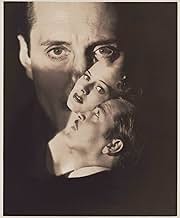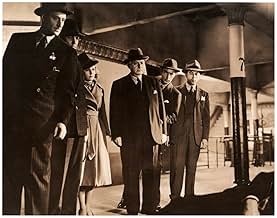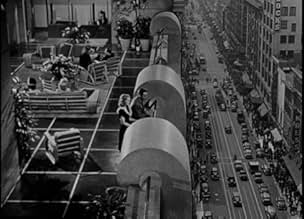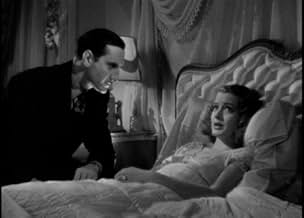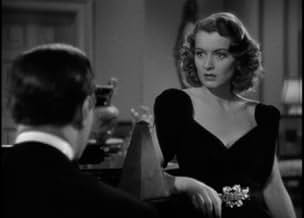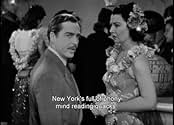Ajouter une intrigue dans votre langueA crazed physician marries a wealthy women and, with the help of his demented assistant, murders them for their money.A crazed physician marries a wealthy women and, with the help of his demented assistant, murders them for their money.A crazed physician marries a wealthy women and, with the help of his demented assistant, murders them for their money.
Barbara Jo Allen
- Louise Watkins
- (as Barbara Allen [Vera Vague])
Bobby Barber
- Bald Man in Library
- (non crédité)
William 'Billy' Benedict
- Mickey Barnes - Copy Boy
- (non crédité)
George Chandler
- Elevator Operator
- (non crédité)
Edward Earle
- Librarian
- (non crédité)
Chuck Hamilton
- Police Officer at Train Station
- (non crédité)
Sam Harris
- Passerby
- (non crédité)
Harry Hayden
- Ticket Clerk
- (non crédité)
Douglas Kennedy
- Hotel Clerk
- (non crédité)
Settar Körmükçü
- Dr. David Profesor
- (non crédité)
John Laing
- Intern
- (non crédité)
Avis à la une
Doctor Ralph Morgan calls at Basil Rathbone's home. His patient, Rathbone's wife, has died. Morgan is suspicious; she was recovering. He does nothing about it.
His suspicions are justified. Rathbone speaks with his manservant, Martin Kosleck, of how much he despised his rich wife and her stupid town, just like his other victims. They will return to New York, and he to his practice as a psychiatrist. There he is hired to deal with Ellen Drew, a depressed and suicidal socialite whose newspaper boyfriend, John Howard, has his suspicions. His investigations lead him to Morgan, even as Miss Drew marries Rathbone.
Rathbone offers his usual graceful performance as a man struggling with redemption. Most noteworthy of all, however, is Ellen Drew's performance as someone suicidal when we first meet her, to someone lighthearted after the ordinary pleasures of Coney Island. Alas, there is no sign of revival of her psychoses at the end, but in that era, endings had to be happy, even in a movie that focuses on Rathbone's attempts to deal with his own dark desires.
Hecht and MacArthur did uncredited work on the script, and they undoubtedly gave the producers what they asked for; neither was director Tim Whelan the man to stand up for a darker vision; he had returned to the US doing work on Korda's THE THIEF OF BAGDAD, and this was his first movie after that. It was no time to antagonize the brass at Paramount.
His suspicions are justified. Rathbone speaks with his manservant, Martin Kosleck, of how much he despised his rich wife and her stupid town, just like his other victims. They will return to New York, and he to his practice as a psychiatrist. There he is hired to deal with Ellen Drew, a depressed and suicidal socialite whose newspaper boyfriend, John Howard, has his suspicions. His investigations lead him to Morgan, even as Miss Drew marries Rathbone.
Rathbone offers his usual graceful performance as a man struggling with redemption. Most noteworthy of all, however, is Ellen Drew's performance as someone suicidal when we first meet her, to someone lighthearted after the ordinary pleasures of Coney Island. Alas, there is no sign of revival of her psychoses at the end, but in that era, endings had to be happy, even in a movie that focuses on Rathbone's attempts to deal with his own dark desires.
Hecht and MacArthur did uncredited work on the script, and they undoubtedly gave the producers what they asked for; neither was director Tim Whelan the man to stand up for a darker vision; he had returned to the US doing work on Korda's THE THIEF OF BAGDAD, and this was his first movie after that. It was no time to antagonize the brass at Paramount.
This Unusual Film "Forecasts" an Anticipation of a Sub-Genre of Film-Noir. The Mental-Health Field...
It was Perhaps, the Dark Genre Most Go-To Subject-Matter with Psychiatry and the Many Unknowns and Rife with Controversy.
To Diagnosis Apart from the Usual Scientific Method that Resulted in "Evidence" from the Material-World.
The Methods Used in the Dual Practices of "Health-Care" were Mostly Diametrically Opposed in the Historical-Record. But with Sigmund Freud and His Peers Bringing the Field into Close Proximity "Hard-Science".
Treating Suffering Patients Needs, by Qualified Practitioners, Should be Taken Seriously. Not Dismissed and Ridiculed.
In 1940, the "Mad" in the Title Makes the Movie Sound Like a "Horror Movie". But, This Film Never Stray from its Roots of "Thriller",
It Explores Very-Dark, Complex Behavior.
Basil Rathbone Creating Charm, a Suave Demeanor, with a Confident Delivery of His "Svengali-Like" Power,
Dreamy-Eyed Ellen Drew is Overwhelmed by a Childhood Death or Her Father, by Suicide with Ensuing Nightmares.
She is Fine as a Victim of Trauma, and Handles the Complexity with an Essential Performance.
Another Reason this Forgotten Film is Required Viewing...
A Quirky Element that was Extremely Rare and Almost Non-Existent in "The Code" Years. An In-Your-Face Gay Couple. The Movie Doesn't Try and Hide it, although it Never Verbally Reveals it, but it's On-Screen with a Multitude of Stereo-Typical Behavior by Rathbone and His Companion.
It's On-Screen for Every-One from the Trailer-Park to the Penthouse to Understand. It's there, No Subtlety.
"The Mad Doctor" is a Hidden-Gem...
Wildly Unknown, and a Treat for Film-Fans that Love Discovering and Appreciating Movies that have a Certain Anti-Routine Approach and Takes Chances...
Willing to Create Outside Conventional Attitudes and Expectations in the World of "The Most Popular Art-Form of the 20th Century".
It was Perhaps, the Dark Genre Most Go-To Subject-Matter with Psychiatry and the Many Unknowns and Rife with Controversy.
To Diagnosis Apart from the Usual Scientific Method that Resulted in "Evidence" from the Material-World.
The Methods Used in the Dual Practices of "Health-Care" were Mostly Diametrically Opposed in the Historical-Record. But with Sigmund Freud and His Peers Bringing the Field into Close Proximity "Hard-Science".
Treating Suffering Patients Needs, by Qualified Practitioners, Should be Taken Seriously. Not Dismissed and Ridiculed.
In 1940, the "Mad" in the Title Makes the Movie Sound Like a "Horror Movie". But, This Film Never Stray from its Roots of "Thriller",
It Explores Very-Dark, Complex Behavior.
Basil Rathbone Creating Charm, a Suave Demeanor, with a Confident Delivery of His "Svengali-Like" Power,
Dreamy-Eyed Ellen Drew is Overwhelmed by a Childhood Death or Her Father, by Suicide with Ensuing Nightmares.
She is Fine as a Victim of Trauma, and Handles the Complexity with an Essential Performance.
Another Reason this Forgotten Film is Required Viewing...
A Quirky Element that was Extremely Rare and Almost Non-Existent in "The Code" Years. An In-Your-Face Gay Couple. The Movie Doesn't Try and Hide it, although it Never Verbally Reveals it, but it's On-Screen with a Multitude of Stereo-Typical Behavior by Rathbone and His Companion.
It's On-Screen for Every-One from the Trailer-Park to the Penthouse to Understand. It's there, No Subtlety.
"The Mad Doctor" is a Hidden-Gem...
Wildly Unknown, and a Treat for Film-Fans that Love Discovering and Appreciating Movies that have a Certain Anti-Routine Approach and Takes Chances...
Willing to Create Outside Conventional Attitudes and Expectations in the World of "The Most Popular Art-Form of the 20th Century".
"Oh, there's no such thing as sanity. At it's best a heroic and precarious little hiding place in which we try to conceal ourselves from the devils...The devils of time, space, things unknown, and the past."
Although its title suggests conventional horror, "The Mad Doctor" is a pitch black thriller with some with some truly harrowing subject matter. Basil Rathbone plays Dr. Sebastien, a Bluebeard-like psychiatrist who recently killed off his wealthy wife Ida. After arousing the suspicion of local doctor Ralph Morgan, Rathbone leaves town. He soon finds his next mark, a deeply troubled young socialite named Linda that's been suffering with suicidal ideations.
Rathbone is accompanied in his efforts by Martin Kosleck as Maurice, a sort of male secretary. After seeing these two interact, it becomes very clear that they are more than criminal accomplices. When we see Kosleck in Rathbone's home or office, he's variously arranging flowers, spritzing himself with cologne, fussing with Rathbone over a choice of tie, and languorously sketching a black cat while wearing a bathrobe. When Rathbone starts to become genuinely interested in Linda, Kosleck responds with wounded jealousy.
This is very obviously a coded gay relationship, years ahead of the one in Hitchcock's "Rope." The scenes between Rathbone and Kosleck, both superb actors, positively crackle. In one scene, Rathbone gives a bone chilling monologue describing his contempt for dead wife Ida: "These atrocious paintings. This absurd wallpaper. These pathetic antiques. They all breathe her spirit. I can almost see her now coming down those stairs with that foolish smile and the love light in her eyes. I can never forgive her the eight months spent in this cave of romance."
The danger and intensity only ratchet up from there, climaxing in a truly haunting and beautifully executed ending. This is one of Basil Rathbone's most underrated films.
Although its title suggests conventional horror, "The Mad Doctor" is a pitch black thriller with some with some truly harrowing subject matter. Basil Rathbone plays Dr. Sebastien, a Bluebeard-like psychiatrist who recently killed off his wealthy wife Ida. After arousing the suspicion of local doctor Ralph Morgan, Rathbone leaves town. He soon finds his next mark, a deeply troubled young socialite named Linda that's been suffering with suicidal ideations.
Rathbone is accompanied in his efforts by Martin Kosleck as Maurice, a sort of male secretary. After seeing these two interact, it becomes very clear that they are more than criminal accomplices. When we see Kosleck in Rathbone's home or office, he's variously arranging flowers, spritzing himself with cologne, fussing with Rathbone over a choice of tie, and languorously sketching a black cat while wearing a bathrobe. When Rathbone starts to become genuinely interested in Linda, Kosleck responds with wounded jealousy.
This is very obviously a coded gay relationship, years ahead of the one in Hitchcock's "Rope." The scenes between Rathbone and Kosleck, both superb actors, positively crackle. In one scene, Rathbone gives a bone chilling monologue describing his contempt for dead wife Ida: "These atrocious paintings. This absurd wallpaper. These pathetic antiques. They all breathe her spirit. I can almost see her now coming down those stairs with that foolish smile and the love light in her eyes. I can never forgive her the eight months spent in this cave of romance."
The danger and intensity only ratchet up from there, climaxing in a truly haunting and beautifully executed ending. This is one of Basil Rathbone's most underrated films.
There is something really quite sinister to Basil Rathbone's title performance in this rather intimidating psychological thriller. We know from the outset that he has disposed of his wife "Ida" - ostensibly pneumonia - but the local physician "Dr. Downer" (Ralph Morgan) is suspicious. Shortly after cleaning up on the inheritance, he moves with his friend "Maurice" (Martin Kosleck) to start afresh. Now you don't have to be Einstein to recognise that these two men are more than just roomies, and that causes a bit of consternation when "Dr. Sebastian" finds new prey. This time, in the guise of the deeply troubled "Linda" (Ellen Drew). With a marriage and a trip to Quito on the cards, might history be about to repeat itself? Well, fortunately for "Linda" reporter "Sawyer" (John Howard) is also a bit suspicious of the man, and after a bit of investigation and a chat with "Downer", the two begin to piece together quite a different persona for Rathbone than the one he has been successful peddling thus far. Can they act in time to thwart his malevolent plan? Tim Whelan allows his star to exude menace here. The script is really only adequate, but the pace is good and the gradually accumulating sense of peril - and a wonderfully seedy contribution from the increasingly envious "Maurice" leads us towards a conclusion where nothing is predictable. Actually, on that front I was a little disappointed, but all in all, this is a dark and effective tale of manipulation that is well worth a watch.
Strangely lacklustre reviews to this quite novel 1940 Noir. Insightful, knowledgeable scripting, wonderful schwartz photography from Ted Tetzlaff. A sinister Rathbone undulating between predator and smitten, with both his male accomplice and the full lips of Ellen Drew on the way to more resolute acting ahead. The opening 10 minute rainstorm introduces the maelstrom perfectly and it continues at a good pace, with a variety of well edited sequences adding to the narrative flow, the high night time shots above 5th Avenue conjured well by subtle SFX. The ubiquitous Ben Hecht had a hand in the screenplay, alongside Harold J. Green, and it shows in this robust, ballsy psycho-drama.
Le saviez-vous
- AnecdotesOne of over 700 Paramount Productions, filmed between 1929 and 1949, which were sold to MCA/Universal in 1958 for television distribution, and have been owned and controlled by Universal ever since; its earliest documented telecast took place in Seattle Monday 11 May 1959 on KIRO (Channel 7).
- GaffesAt the Library, Sebastien shades over a page with a pencil to see the impression of what was written there earlier but when he tears the page off the pad, the page is untouched.
- Citations
Maurice Gretz: You're like all the other clever ones, clever until they meet a woman, and then they suddenly become fools.
- ConnexionsReferenced in Svengoolie: Night Monster (2015)
- Bandes originalesAloha 'Oe
Music by Queen Liliuokalani
Meilleurs choix
Connectez-vous pour évaluer et suivre la liste de favoris afin de recevoir des recommandations personnalisées
- How long is The Mad Doctor?Alimenté par Alexa
Détails
- Date de sortie
- Pays d’origine
- Langue
- Aussi connu sous le nom de
- La cita fatal
- Lieux de tournage
- Société de production
- Voir plus de crédits d'entreprise sur IMDbPro
- Durée
- 1h 30min(90 min)
- Couleur
- Rapport de forme
- 1.37 : 1
Contribuer à cette page
Suggérer une modification ou ajouter du contenu manquant

